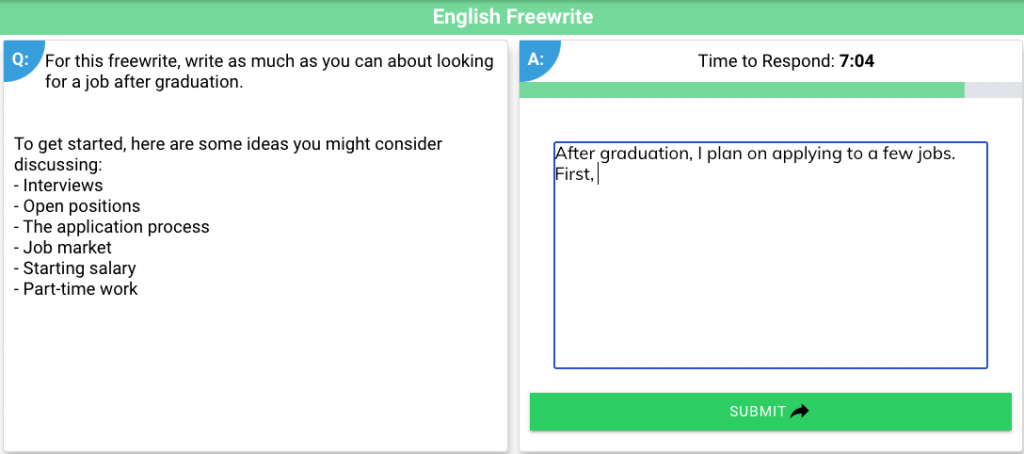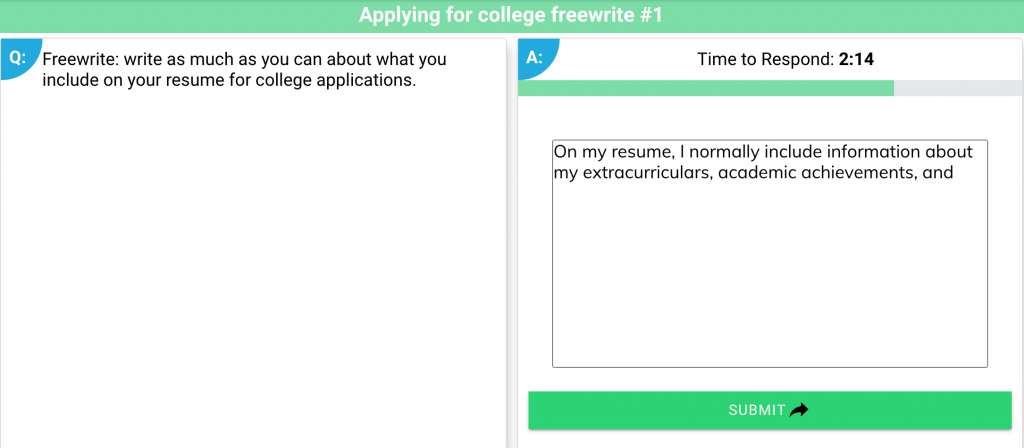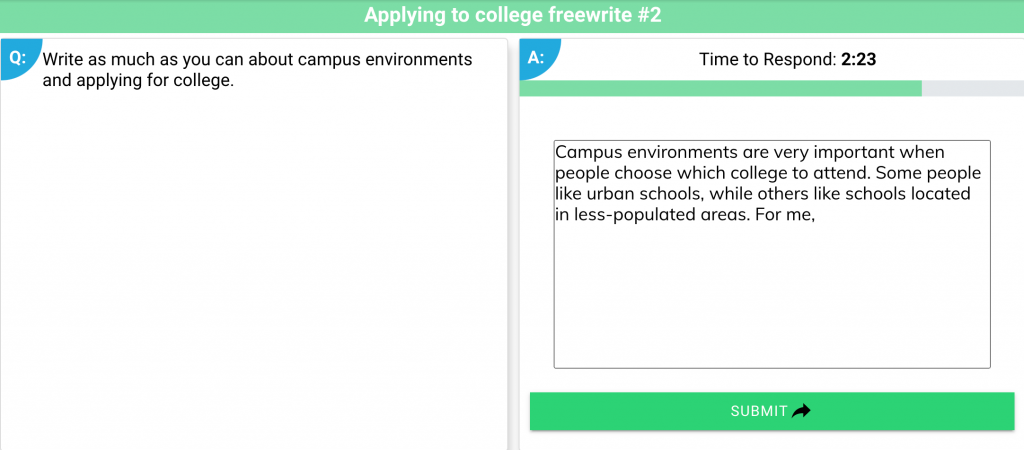
If your students were dropped into the target language environment by themselves right at this second, what could they do? Could they survive with more than just primitive hand signals? “Freewrite” and “freetalk” assignments give you those answers. These tasks allow students to show what they can do in the target language with no (okay, maybe just a few) strings attached. For clarity, let’s define them below.
- Freewrite*: A task where students write about anything in the target language for a set period of time. There are minimal, if any requirements in regards to grammar, vocabulary, or content. Students are encouraged to simply write what is on their mind using the language they know.
- Freetalk: Same as a freewrite, except done orally and (likely) for shorter amounts of time.
*Note: for the sake of brevity and unnecessary repetition, I’ll stick with talking about just “freewrites” in this article. Most of the tips for freewrites are directly applicable to “freetalks” as well, except those I mention in particular.
Now, this is not to say that all freewrites are or should be assigned by saying, “Okay class, go write for fifteen minutes in French” with no other direction whatsoever. In fact, freewrites that produce the highest quality work normally have a few constraints and/or requirements, as most students do need a little push. But be careful not to supply too much, as students will get caught up in the requirements and lose focus of the actual goal: spontaneous, unplanned output in the target language. To figure out how to optimize these assignments, experiment! Give your novice classes zero requirements and give your advanced classes only three, or vise-versa. For example, you could push advanced students to write about summer plans without consulting any resources, while you might allow your novice-level students to look at their vocabulary Quizlets for two minutes prior to writing about their weekends. Don’t be afraid to differentiate for individual students either. If Trevor is your all-star novice German speaker, challenge him to speak for a minute straight. If you’re lucky to get Denise to even raise her hand in class, give her some scaffolding like sentence starters or interjections. There’s no single way to construct a freewrite task: find out what works best for your students.
In-depth freewrite webinar
In the webinar recording below, Grant breaks down freewrites and explains how to integrate them into world language classrooms.
Why assign freewrites?
The best part about freewrites is that there are virtually no rules. No set amount of conjugations, no mandatory transition words, no five-paragraph essay structure. With requirements and checklists out the door, students are empowered to choose what they want to talk about. Of course instructors can provide guidelines that lead students in the right direction, and indeed these can help, but by their very nature, freewrites are bare bones, “get writing!” exercises.
At their core, freewrites allow language educators to see what their students can do right now. Do other types of assessments also do this? Sure they do. But often in these other modes, we educators provide immense scaffolding for students. While there’s nothing wrong with that, ascertaining what students can do with the language on their own and with no guidelines, including how they use it creatively, is crucial to assessing their overall progress since they first started. Freewrites open the door to this knowledge.
I mentioned creativity. Through freewrites, students are forced to use the target language creatively, something that many of them shy away from even in more structured assignments. For students (particularly advanced learners), freewrites create a unique chance to “play with” and experiment with the language in new ways. In academic parlance, this is called hypothesis testing. Good language students remember vocabulary and grammar rules. Great language learners know that to make real progress, you have to be able to take what you know and make educated guesses. You hypothesize! Take an example of someone learning Spanish: “If I know that a futbolista is someone who plays soccer, then can I say basquetbolista for someone who plays basketball?” Indeed, you can! The bell rings. The light bulb goes off. The mind is blown. These are the quintessential “aha!” moments that not only contribute to students’ proficiency, but also build their confidence in learning the target language. You might be thinking, “my students can barely conjugate tener or avoir properly, how could they ever start doing this?” Indeed, hypothesis testing is an advanced skill, but that doesn’t mean you shouldn’t encourage your kids to try. How do we do this? Unfortunately, we can’t just say “Go and hypothesis test!” Instead, we start by telling students, early and often, that making mistakes and learning from them is how we develop proficiency in foreign languages (and become better people, for that matter). Not only that, but making mistakes can show students that they can learn languages without teachers holding their hand. By cultivating not just smart hypothesizing but more importantly the willingness to do so, we liberate learners from their affective filters and open doors for endless growth in the target language. I went out on a tangent here, but my point remains the same: properly constructed freewrites demand creativity from our students.
When?
Believe it or not, the time you assign freewrites is critical if you are using it as an assessment tool. When you assign them in the context of your unit will greatly determine student outcomes. Thus, you can’t assign freewrites every week. Like anything else overused, students will grow tired of them and they will diminish in value.
There are two appropriate occasions to assign freewrites: at the beginning of a unit and at the end of a unit. As a note, pre-unit freewrites should be used for students to preview what they know about a given topic, and as such they likely won’t be a reliable assessment tool. Pre-unit freewrites are best suited for intermediate and advanced students as they will likely have subsequent vocabulary to write about the topic, while novice learners may be limited in what they can produce.
On the other hand, post-unit freewrites should be given after the completion of all final projects, quizzes, tests, or whatever represents unit culmination for you. Regardless of how you end your unit, it’s important that you assign your freewrite after completing all relevant unit objectives, whether linguistic or cultural. Only then can students show their level of comfort with the material they have come to understand. An added benefit to using pre-unit and post-unit freewrites? When paired with one written at the beginning of a unit, post-unit freewrites provide detailed data to measure student progress.
Using Extempore for freewrites
Freewrite Type 1 - One question, 8-10 minutes
There are two types of freewrite assignments to consider. The first is the basic, one-question freewrite, where students will have a set amount of time to write about a given topic.

One of the most important factors of a freewrite is an appropriate amount of time for students to perform. For a typical freewrite, I tend to lean on the side of more time just to account for errors, correction, and the adjustment of typing in a new language. Eight to ten minutes is usually more than enough time for students to compose a short freewrite.

I mentioned earlier that well-designed freewrites usually have elements included to “push” students who need encouragement / ideas to get started. When considering what can aid students, keep these pieces broad and open-ended. Think about the various features of a given topic. For example, if your unit focus on work and post-graduation plans, you might have students write about acquiring a job. Aside from looking for jobs, obtaining employment involves applying, going to interviews, considering different positions, understanding the job market, seeking part-time work, etc. Similarly, if your students learned about choosing a college, you could encourage them to focus on campus environment, programs offered, extracurriculars, distance from home, notable professors, etc. By giving students broad options, we encourage student choice and allow for a variety of response types.
Freewrite Type 2 - Multiple questions, 2-3 minutes per question
The second type of freewrite splits up different topics into multiple questions, allowing students to write short responses with breaks in between. This method can be useful if you are looking to emphasize certain cultural phenomena or ideas within a given unit.


Freewrites can also be split into multiple questions, focusing on specific topics and using shorter response times.
Regardless of which method you choose, it’s important to note that what distinguishes freewrites from basic question and answer prompts is just that: freewrites are not questions; instead, they are opportunities for students to discuss a given topic in however way they see fit. As such, students’ only goal in a freewrite is to communicate a message about a topic, just how they would in the target languaculture. The content of that message is entirely up to them.
Freewrites by Language Level: Tips and Examples
Unsurprisingly, freewrites will differ depending on the level of your students. Let’s take a look at designing freewrites for each level, including some practical examples.
Novice Levels
Even at the novice-mid level, students may face difficulties when composing freewrites. As such, stick to a common theme like personal introductions. So much of novice-level language learning involves talking about oneself, including personal background, hobbies, interests, school life, or a number of other topics. Your students will probably find themselves writing / speaking phrases over and over, but what's important is that they are producing the language consistently, and this repetition comprises the foundation of future language growth.
Examples
- Talk about yourself.
- Write about your hobbies.
- Tell a friend about your school life.
- Explain your weekend plans.
Intermediate Levels
At the intermediate level, students should have a basic semantic and linguistic grasp of the target language, allowing them to communicate on a number of different topics. Knowing this, instructors can start to add in required language elements or "pushes" like those mentioned above. Keep in mind though, too many requirements will cause students to forget the purpose of the freewrite and use unnatural, stilted language.
Examples
- French: Talk about what you want to do in the future.
- Language requirement: use être in the future tense at least once.
- Chinese: Discuss your favorite and least favorite restaurants.
- Language requirement: use 虽然.....但是 at least once.
- Spanish: Write about life at school last year.
- Language requirement: use tener in the imperfect tense at least once.
Advanced Levels
The advantage of advanced levels is that students should have ample vocabulary and language patterns to employ in freewrites. With a fully-loaded linguistic arsenal at their behest, students should be encouraged to illustrate their lexical and grammatical prowess and creativity in these open-ended writing tasks. Of course, there will still be students who require the aforementioned "push," and this encouragement can come in a variety of forms. Let's see some examples.
Examples
- French: Talk about anything related to travel preparation.
- Push: You lost your passport. What do you do?
- Chinese: Discuss technology in your life.
- Push: Introduce a popular Chinese app.
- Spanish: Write about art in your home.
- Push: Talk about your favorite painting.
Recap
Freewrites can reveal considerable information about student progress, creativity, and understanding. Whether your novice students are getting their feet wet, or your advanced students are showing off their strong skills, you can use freewrites and freetalks as a canvas for their linguistic exploration and ability. Play around with the different ways to modify these assignments and challenge your students to create new language from what they've learned. Now let's get writing!



